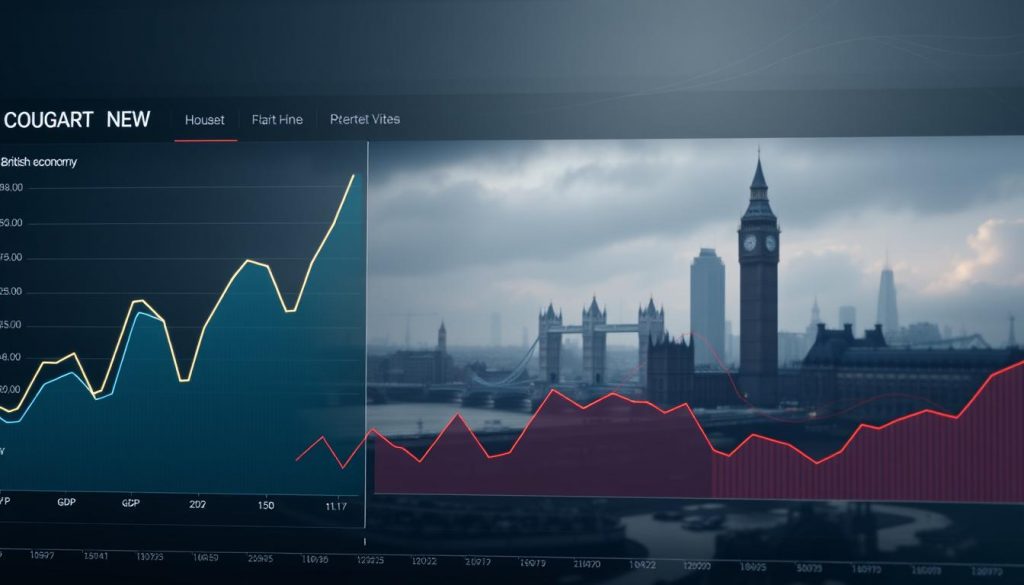Is the recent slide in sterling a sign of looming economic trouble, or a short-lived market wobble?
The UK economy faces a tricky mix of sticky inflation, higher borrowing costs and global headwinds. This week’s GDP report is highly anticipated by global markets and will shape expectations for growth and the near-term outlook.
Investors are watching data closely because the outcome will guide the Bank of England and set the tone for equities, FX and international flows. Safe-haven demand has helped the dollar rise, weighing on the pound as traders reassess risk.
While nominal UK GDP hit a record $3.64 trillion in 2024, momentum and real growth matter more now. The central concerns for sterling and gilts stem from mixed services resilience, squeezed households and firms, and the policy path that follows the new report.
The aim here is informational: outline market reactions, the drivers behind the slide, links to recession fears and what signals to monitor rather than alarm readers.
Key Takeaways
- The GDP report this week could shift growth expectations and market sentiment.
- Investors will parse the data for signs that influence the Bank of England’s policy moves.
- Safe‑haven flows have strengthened the dollar and pressured sterling at sensitive moments.
- Record nominal GDP in 2024 masks concerns about momentum and real activity.
- Currency moves matter for import prices, household budgets and business confidence.
Latest stock market news: Sterling slides as UK GDP takes centre stage
Markets are focused on the upcoming GDP print as a key trigger for stocks and FX.
UK stock market news: domestic equities brace for GDP surprise
The GDP report this week will set the tone for domestic shares. A stronger reading could lift banks and financials, while a weak print may push investors into defensive names.
Recent economic news and why it matters for investors
Sterling has weakened versus the dollar after firmer US figures and safe‑haven flows. That shift can raise import prices and squeeze margins for retailers and manufacturers.
| Sector | Stronger GDP | Weaker GDP | Why it moves |
|---|---|---|---|
| Financials | Outperform | Lag | Rates and lending growth |
| Defensives | Stable | Outperform | Safe income and resilience |
| Industrials & Retail | Mixed | Under pressure | Demand and input costs |
“Traders expect sharp moves when the figures land; volatility often follows a surprise.”
- Watch services PMIs, wages and inflation alongside the report.
- Consider hedging FX and sector exposure into the week.
- Scan company updates to recalibrate earnings expectations.
The Pound’s Plight: signals from currency and credit markets
Volatility in FX and bond markets has risen as investors digest stronger US releases and upcoming UK data. Safe‑haven demand has bolstered the dollar, adding visible pressure on the pound in recent sessions.
Pressure from safe‑haven flows
Traders moved into the US unit after surprisingly firm US jobs and activity prints. That flow has amplified moves in pound crosses where liquidity thins around major releases.
Gilts, corporate bonds and market confidence
UK credit markets transmit shifts in yields to borrowing costs and market sentiment. During the 2022 mini‑budget episode gilt yields spiked and the bank england intervened to restore orderly function.
| Market | Typical reaction to weak UK GDP | Risk channel | Signal to watch |
|---|---|---|---|
| FX | Sterling softens | Safe‑haven flows | Options skew |
| Gilts | Yields rise | Funding costs | Swap spreads |
| Corporate debt | Spreads widen | Credit availability | CDS & issuance volumes |
What moves next?
Expect rates and swap markets to react quickly to surprises, affecting mortgages and corporate borrowing. Desks will key off the GDP print and commentary for directional cues.
“Signals from options pricing and credit spreads will help gauge perceived tail risks after the data.”
Confidence in fiscal and monetary settings matters. Loss of credibility raises funding costs and deepens concerns about growth and market stability.
Why is the Pound Falling? The Causes
Several linked forces have driven sterling lower in recent years, from rate gaps to questions about fiscal credibility.
Rate gaps and yield expectations
Interest rates and expected paths versus peers shape flows. Higher yields abroad make other currencies more attractive, changing the yield differential that moves capital and exchange rates.
Inflation and price shocks
Persistent inflation, driven by energy and food, has complicated the Bank of England’s outlook. Global supply shifts and the Ukraine war pushed up prices, adding to household strain.
Policy credibility and public finances
The 2022 mini‑budget’s unfunded tax cuts undermined government trust, spurring gilt sell‑offs until reversals restored calm. Loss of credibility raises sovereign risk premia and borrowing costs.
Structural trade and productivity issues
The UK runs a persistent trade deficit, importing more goods and services than it exports. Weak productivity and low business investment since 2016 have limited competitiveness and trend growth.
Markets now watch fiscal plans, OBR assessments and credible consolidation paths. Restoring confidence needs predictable policy and medium‑term reforms to boost growth and stabilise the currency.
The link to recession fears: reading the UK economy news
Recent data swings have sharpened debate over whether slowing activity will tip the UK into a prolonged downturn. Slower growth shows up first in spending and hiring, then in output and retail receipts.

BoE’s dilemma: inflation versus growth risks
The Bank of England faces a clear trade‑off. It must curb inflation while trying not to deepen any contraction.
Past tightening in 2022 raised rates sharply and warned of higher unemployment and mortgage costs as fixed deals expire. Future decisions will lean on fresh readings to strike a balance.
Unemployment, spending and the services sector pulse
Households face mortgage resets, bigger energy bills and weak confidence. These headwinds can trim discretionary spending and weigh on the consumer.
Services activity has been more resilient and can buffer the wider slowdown. But if output, retail sales and surveys fall together, recessionary fears intensify quickly.
“Policymakers will watch GDP, labour markets and inflation closely to calibrate the path ahead.”
For timely context on recent moves in the UK, see the latest uk economy news.
Market reactions to watch: stock market trends, FX and gilts
Traders brace for sharp moves as GDP figures land, with equities, FX and gilts all prone to quick re‑pricing.
The upcoming report will test positioning and liquidity, forcing fast decisions by investors across asset classes.
Stock market UK: sector winners and laggards on GDP prints
Domestic equities often react sharply. A stronger print tends to lift financials and cyclicals.
Weak data usually boosts defensives and utilities as risk appetite fades.
FX watchlist: pound‑dollar and spillovers to import prices
The pound can spike on an upside surprise or slide if activity disappoints. Movements feed through to input prices for retailers and manufacturers.
Options flow and skew help show how the market prices short‑term risk around the figures.
Rates and gilts: what shifting yields signal for risk
Expect gilt yields to move as traders adjust the expected rate path. That alters borrowing costs and financial conditions in real time.
Yield‑curve shifts change earnings discount rates and flag recession risk if inversion widens.
| Asset | Reaction to stronger GDP | Reaction to weaker GDP | Key signal |
|---|---|---|---|
| UK equities | Financials & cyclicals outperform | Defensives lead | Sector rotation |
| FX (GBP/USD) | Pound gains, import costs ease | Pound weakens, input prices rise | Options skew & flows |
| Gilts | Yields fall if less hawkish | Yields rise on tightening bias | Swap spreads & issuance |
“Post‑release guidance and press briefings often shape the second‑day narrative as desks reassess positioning.”
Liquidity can thin around the figures, so many use options or hedges to manage gap risk. Cross‑asset moves often conflict intraday before a clear market story emerges.
What this means for the average person and for businesses
Rising mortgage charges and volatile import costs are altering monthly spending and corporate forecasts. The immediate effects show up in household budgets and in boardrooms as plans are revised.
Households: mortgages, energy costs and real incomes
Many consumers see mortgage repayments jump as fixed deals end, trimming discretionary spending each month.
Energy bills remain elevated and squeeze real incomes, forcing households to prioritise essentials over luxuries.
At this level of strain, retail and leisure sectors may feel weaker footfall and lower ticket values.
Companies: input costs, trade exposure and investment plans
Companies that import face swings in input costs when the exchange rate moves. Some pass higher prices to customers; others absorb margins and cut investment.
Interest expenses rise for firms with floating debt, raising refinancing risk as maturities near.
- Many businesses hedge currency to stabilise costs and protect margins.
- Cash buffers and flexible cost bases help resilience in uncertain time.
- Investment often waits until outlooks clear, slowing productivity gains.
“Review fixed versus variable interest, negotiate supplier terms and explore energy efficiency to reduce near‑term strain.”
Trade and global context: us trade market and uk trade market
Diverging growth paths have redirected investor funds, altering trade patterns and currency dynamics.
The US has seen steady job growth and resilient consumption, which supports a strong dollar and draws capital into US assets. That flow boosts the US trade market and tightens financial conditions elsewhere.
Divergence and investor flows
When one economy outperforms, global funds chase yield and stability. That often raises equity and bond prices in the winning country, reinforcing currency strength and attracting more investment.
Implications for imports, exports and sectors
The UK runs a persistent trade deficit and imports more goods and services than it exports. A weaker exchange rate can help exporters but raises costs for importers.
- Retailers, travel and manufacturing feel FX swings most acutely.
- Energy and logistics repricing after the Ukraine war has shifted relative competitiveness for many firms.
- Monitoring export order books and import cost indices gives an early read on trade momentum.
Trade balances and current account financing shape long‑run currency trends. Practical policy moves and trade deals, such as discussions on UK‑US trade and tariffs, can ease frictions and open new markets.
“Flows follow growth; trade policy can help tilt outcomes but cannot fully offset large macro gaps.”
Pound Under Pressure – Should Britain Fear Recession? A cause for caution, not panic
The next set of releases will tell whether recent soft spots are temporary or persistent. Markets will key off GDP and inflation prints, plus Bank of England guidance, to shape near-term expectations.

Signals to monitor: GDP, inflation prints and policy guidance
Key signals are the GDP report, CPI releases and official communications from the Bank, which are crucial for understanding the latest uk stock market news. These data and the subsequent commentary will steer market views on the likely path for rates and the terminal rate, providing valuable insights for the forecast.
Clarity in policy can calm volatility even when numbers are mixed. Traders will parse month-on-month trends, wages and service activity to build conviction.
Positioning for uncertainty: risk management for investors and firms
Investors will favour quality balance sheets and resilient cash flows. Firms will stress-test financing under varied conditions and align spending with realistic revenue paths.
- Maintain liquidity: stagger maturities and keep committed lines.
- Hedge selectively: measured FX and rates hedging over the next months.
- Scenario test: run downside and base-case models to build confidence in forecasts.
| Focus | Action | Why it matters |
|---|---|---|
| Policy guidance | Monitor BoE statements | Shapes expectations for rate decisions |
| Data flow | Track GDP & CPI | Direct input to market pricing |
| Investment stance | Prioritise liquidity & cash generation | Limits downside and preserves optionality |
“A cautious, disciplined approach lets investors and firms take part in any recovery while limiting drawdown risks.”
Conclusion: Pound Under Pressure – Should Britain Fear Recession?
What matters now is whether policy clarity and fiscal credibility can steady markets as data flow in.
The economy sits where slowing growth meets persistent inflation, leaving markets finely tuned to each release. Safe‑haven dollar strength, external demand and domestic credibility combine to shape immediate moves.
The government’s fiscal stance and clearer frameworks matter for funding costs, long‑run investment and market confidence, as highlighted in public finance news today. Investors will watch the path for interest rates and the expected terminal rate as they price earnings.
Rising rates affect business financing and companies’ capex, while consumers face tighter budgets and softer services demand. Spending patterns and energy costs remain leading indicators for margins and household resilience.
Ultimately, the pound is still under pressure, but improved communication from the bank and government, steadying trade flows in the US and UK trade markets, and stabilising growth can reduce downside risks over coming months. Firms should secure credit lines, keep liquidity and pace investment as visibility improves.
For more Finance articles, please follow the link


